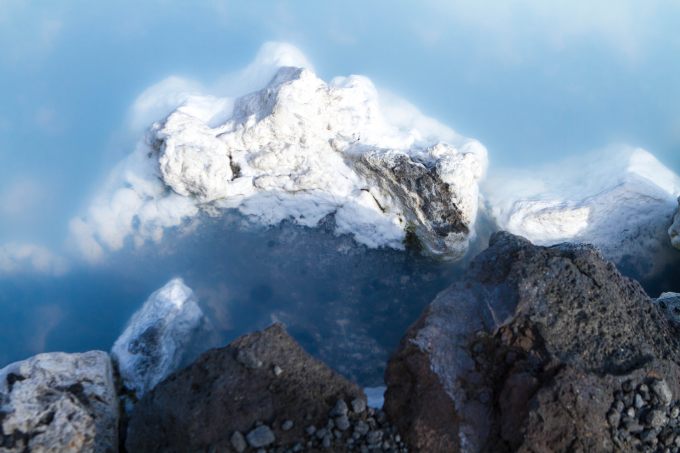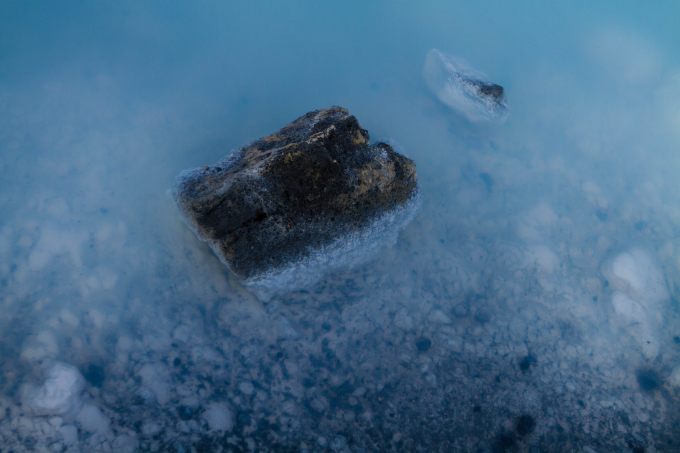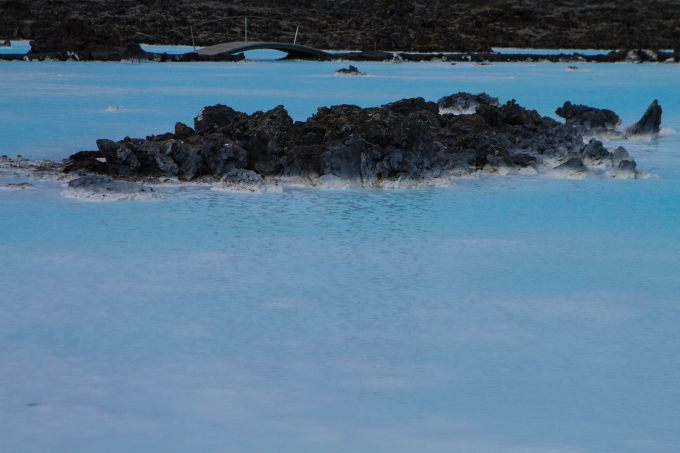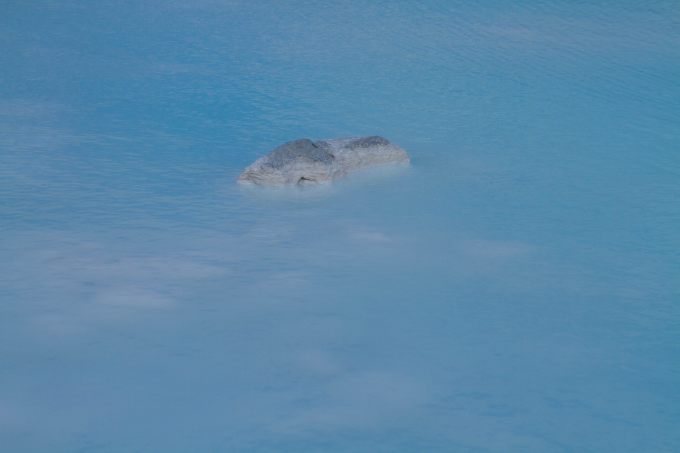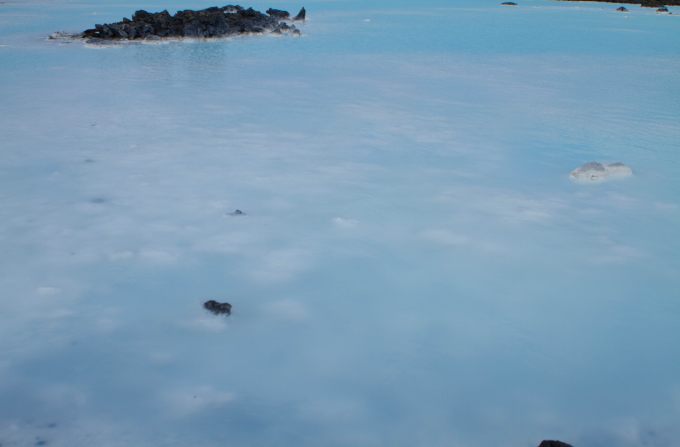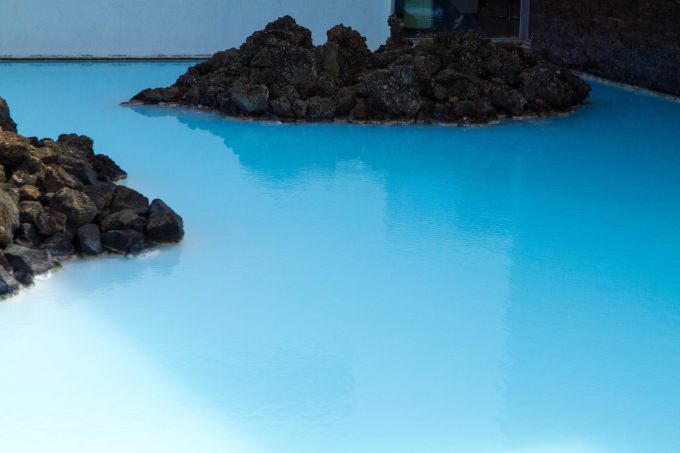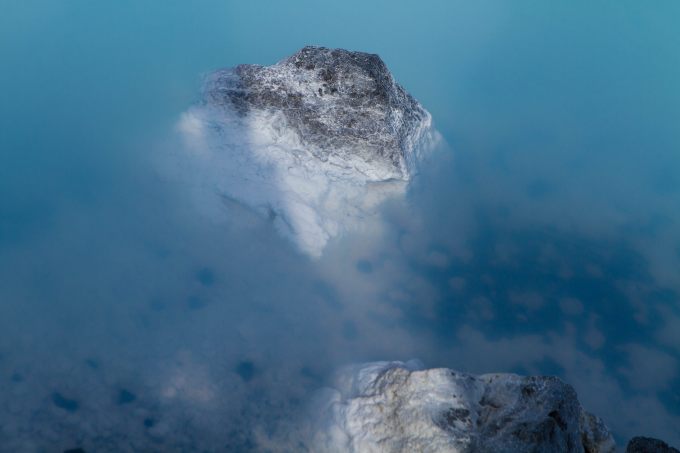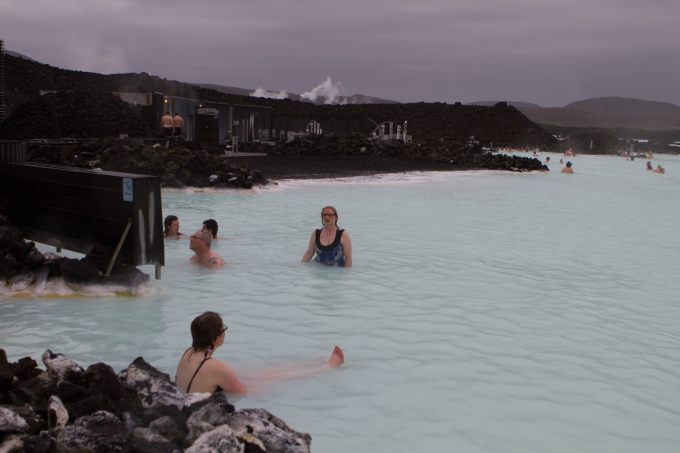You can’t embark on a trip to Iceland without someone in your circles mentioning Blue Lagoon, even if they’ve never been there. There was such a frenzy on it that I emailed the few people I had met on Twitter before I left the states and they all said, “yes, it’s easy, near the airport, and something you could even do on your way into town — allocate a few of hours for it.”
A few hours for an activity that creates this much frenzy? I must admit, I was intrigued and a little bemused.
Blue Lagoon is a geothermal spa where guests relax in seawater heated by Mother Nature herself, roughly 40 minutes from Reykjavik. While some locals do of course go to the lagoon, over 400,000 tourists of the half a million the country gets each year, stop at Blue Lagoon.
In order to understand all the hype, I went there with a local friend who seems to know everyone in the area, on a wet, rainy and windy day. The below shots were taken three weeks later when I returned on a somewhat sunny day.
Note the difference between the “blues” in the first set of photos versus the second set of photos at the bottom of this article. Let’s just say “sun makes a difference!”
Their philosophy is centered around energy and that energy is the “foundation of life.” While the Blue Lagoon isn’t entirely a natural creation in the purest sense, it is using the earth’s creative power as a primordial force to nourish the energy of those who experience its water.
Blue Lagoon’s operation is based on the unique properties of geothermal seawater and the closed ecocycle it belongs to and to be fair, I felt healthier and more revitalized after both visits. The origin of this geothermal seawater is from 2,000 meters beneath the surface and to get to the surface, it travels through porous lava, a blend of sea and fresh water.
In the process, it undergoes mineral exchange and then near the surface, concentration occurs, due to vaporization, evaporation and finally, sedimentation. The geothermal seawater is led directly from the original source to the lagoons at the Blue Lagoon which btw, they position as a “spa,” a geothermal one that is. Be prepared to bathe and lap up the best that silica, minerals and algae can give you in a massive large swimming pool that is as hot in some areas as a traditional hot tub.
I took these intoxicating close up photos in and around the Blue Lagoon’s main pool and yes, it really is that blue, especially on a sunnier day.
I felt a little guilty dragging my new friend who drove me there when he clearly wanted me to see other sites in the area. After all, to a local, its like going to Disneyland and frankly, not something they do in their daily lives for the most part, unless of course they have foreign friends in from out of town. And Disneyland isn’t a bad analogy really, since the spa has become so popular that swarms of buses pour into its parking lot daily.
He told me about the times he used to come there as a teenager and in those days, it was a place where boys wooed girls. Back then of course, it wasn’t a tourist attraction. Blue Lagoon was only formed in 1976, following intensice research aimed at harnessing heat for local municipalities from the Svartsengi geothermal area on the Reykjanes peninsula.
Starting in 1981, people started to bath in the lagoon and psoriasis patients noticed an improvement of their skin condition after bathing in the lagoon and applying silica mud on their skin. Truth be told, my acne, which sadly I still get from time to time, cleared up within hours of being at the lagoon.
A little over ten years later, things really took off and a skin care product line was even launched and shortly thereafter, a restaurant and conference facilities were built. They even have Blue Lagoon shops in Reykjavík and at Keflaví International Airport today. Because of its popularity and the nearly a half million people moving through its doors each year, it has become an international destination along the likes of “Disneyland.”
While I loved the geothermal experience even in the rain (what’s not to love?), it was so crowded, I had a hard time relaxing at first. Bus loads of people from Europe, Asia and North America flew through the gates and the locker room area was so crowded, there wasn’t a dry place to put my bag while I figured the somewhat complex locker system out. It was even more crowded the second time I went three weeks later.
That said, I still had a magical experience (and it is magical), however I think they need to re-think the process to make it less frenzied for visitors as its popularity goes up. While they are most definitely organized, the volume of people alone makes it a little daunting.
One idea would be to have set times that only tour buses can visit leaving other times open for non-groups, such as individuals, families and couples who want more of an intimate or romantic experience.
There has been talk about allocating set times for your visit (one ticket buys you a visit from 2 to 5 for example), which is something I don’t think will work. Iceland is a country of massive weather diversity. Planes and vans can be late because of that weather uncertainty and if people are only in Iceland for a week or less and they miss their window, there may not be an easy other time to visit, especially if they’re on a set itinerary, which most people are.
I think it will create a scheduling chaos not just for tourists individually but for the tour companies who are booking their guests on their behalf. The other reason that this approach is tricky is that some people might stay for four hours, another might stay for two or three and another might be in and out in an hour. Restricting an experience that should be relaxing will have the opposite effect. Personally, I’d suggest allocating about three hours for the experience, maybe 3.5 if the weather is good and you’d like to have some drinks and food there.
The lagoon holds six million liters of geothermal seawater all of which is renewed in 40 hours. In addition to relaxing in the lagoon, guests have access to steam baths and sauna. In-water massage and spa treatments are also available.
All treatments use the active ingredients found in the geothermal seawater, making in-water treatments exclusive to the Blue Lagoon and unique. The signature treatments include silica wrap treatment combined with body and face massage; nourishing and relaxing algae treatment, lava deluxe exfoliation; Silica massage and special deluxe Blue Lagoon massage. Blue Lagoon Spa treatments are developed in-house by its research & development team, Spa therapists, massagers, esthetics, cosmetology scientist with special knowledge in professional Spa product formulation. There’s also a nourishing Algae Treatmen is a unique treatment that awakens the senses, a Relaxing and Rejuvenating Clay Treatment and Massage and Lava, Lava De Luxe treatment based on lava dust from the Blue Lagoon‘s environment.
All guests have access to outdoor saunas, hot tubs with fresh water and geothermal seawater.
They have a tiered pay structure btw, which can be a tad confusing. Note: if you want access to the lounge area, the ticket is more than double what it would cost to go to Disneyland for the entire day. Prices look something like this:
- Standard is 6,400 kronas. (basic entrance, which is roughly $55).
- Comfort: 10,400 kronas. (comfort, which gives you a towel, bathrobe, one free drink, roughly $88)
- Premium: 15,700 kronas. (premium, towel, bathrobe, a drink, towel, food, equating to around $132)
- Luxury: 27,200 kronas. (slippers, towel, bathrobe, food, drink and access to their lounge, which is roughly $230). The main difference between premium and luxury is access to their lounge from what I can tell.
The Blue:
Blue Lagoon silica is the Blue Lagoon’s signature ingredient, formed by silica molecules that polymerize into colloids, which finally create the white silica mud seen in the actual lagoon. The silica holds an important role in treating skin conditions and their latest research reveals its skin repair and anti-aging effects.
The Architecture:
Blue Lagoon’s emphasis on architecture and design is integral for them. Sigríður Sigþórsdóttir, Basalt Architects, is the architect of the Blue Lagoon facilities including Blue Lagoon Bath, Blue Lagoon Clinic and Blue Lagoon Spa in Reykjavík. He says, “I attempted to capture the mystery of the location with the ever changing play of light and shadow across the lava, the steam from the lagoon and the special light that characterizes the northern part of the world. Pure Icelandic materials from moss and stones characterize the design. We wanted to emphasize the relationship between nature and the man-made.”
From the parking lot, there’s a 200-meter footpath that cuts through a wall of lava. It’s like descending into a lava maze, guided by nature into the lagoon itself.
Then, there is the lava wall inside the facility (containing about 70,000 pieces of lava), connecting the building with an untouched lava wall that surrounds the
steaming waters, providing natural shelter for bathers. The building’s soft lines blend with the lava, as it opens towards the lagoon absorbing the northern sun hanging low in the winter or rising high during the endless light of summer.
Should You Go?
Despite the growing crowds, yes, of course you should go. Experiencing Blue Lagoon is something very Icelandic in that it taps into the natural resources of the land. Geothermal is central to the country’s resources and from there, so much of its energy flows. People use it to heat up their homes and water throughout from east to west and north to south. There are healing properties and in my opinion, it likely extends beyond the skin although there’s no scientific studies to prove this cohesively.
Also, there are only two places you can have such an experience and Blue Lagoon is the largest and the only place in the south of the country. Natural Baths in the North is much less built up but it’s a hike to get up there. See our write up on Natural Baths and North Iceland in general, a truly magical part of the country.
My only recommendation is to try to go (if your schedule allows) during a less busy time and bring your own towels. This either means off season (the prices quoted above are peak season which is summer btw, so they’re discounted in the winter) or early or late, perhaps checking with them to identify when a slower time might be to visit. It’s a pretty great experience overall and you can actually swim up to a drink bar and using your wristband, order drinks which you can sip in the lagoon.
As you can see from above, you can swim under bridges and at the far end of the lagoon, there’s a mud tub, where you can cake up your face for a treatment while you’re soaking. Lovely!
One More Thing…
One other thing that is vital to know, especially for women with long hair. Note I DO and this happened to me. While the water from the lagoon is fabulous for your skin, it takes its toll on your hair. Avoid diving under the water as tempting as it may be. There’s sulphur and other natural ingredients that can be drying on your follicles so your hair feels a bit like straw afterwards, which obviously makes it difficult to brush through. Men and women with short hair will likely not experience this issue as much, but if you have long or thick or tangly hair, be forewarned.
One thing that will help and I was advised after the fact. Once you come out of the lagoon, coat your hair with conditioner and leave on for 10-15 minutes before washing it off. Pure oils will also do wonders. Do the same thing for the next couple of days and you should be fine. But, as I said, it was worth it, so go for it and play full out and when you do, remember how fabulous your skin will look and feel after the fact. Once you’re in the lagoon itself, you will be sure to have a smile on your face, rain or shine!
Note: I was hosted by the Blue Lagoon, but all opinions expressed here are clearly my own. For more on Iceland in general, visit our Traveling to Iceland / Travel in Iceland / Iceland section.

Renee Blodgett is the founder of We Blog the World. The site combines the magic of an online culture and travel magazine with a global blog network and has contributors from every continent in the world. Having lived in 10 countries and explored nearly 80, she is an avid traveler, and a lover, observer and participant in cultural diversity.
She is also the CEO and founder of Magic Sauce Media, a new media services consultancy focused on viral marketing, social media, branding, events and PR. For over 20 years, she has helped companies from 12 countries get traction in the market. Known for her global and organic approach to product and corporate launches, Renee practices what she pitches and as an active user of social media, she helps clients navigate digital waters from around the world. Renee has been blogging for over 16 years and regularly writes on her personal blog Down the Avenue, Huffington Post, BlogHer, We Blog the World and other sites. She was ranked #12 Social Media Influencer by Forbes Magazine and is listed as a new media influencer and game changer on various sites and books on the new media revolution. In 2013, she was listed as the 6th most influential woman in social media by Forbes Magazine on a Top 20 List.
Her passion for art, storytelling and photography led to the launch of Magic Sauce Photography, which is a visual extension of her writing, the result of which has led to producing six photo books: Galapagos Islands, London, South Africa, Rome, Urbanization and Ecuador.
Renee is also the co-founder of Traveling Geeks, an initiative that brings entrepreneurs, thought leaders, bloggers, creators, curators and influencers to other countries to share and learn from peers, governments, corporations, and the general public in order to educate, share, evaluate, and promote innovative technologies.

